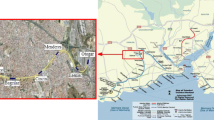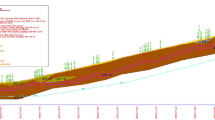Abstract
In this study, short-term surface settlements are predicted for twin tunnels, which are to be excavated in the chainage of 0 + 850 to 0 + 900 m between the Esenler and Kirazlı stations of the Istanbul Metro line, which is 4 km in length. The total length of the excavation line is 21.2 km between Esenler and Basaksehir. Tunnels are excavated by employing two earth pressure balance (EPB) tunnel boring machines (TBMs) that have twin tubes of 6.5 m diameter and with 14 m distance from center to center. The TBM in the right tube follows about 100 m behind the other tube. Segmental lining of 1.4 m length is currently employed as the final support. Settlement predictions are performed with finite element method by using Plaxis finite element program. Excavation, ground support and face support steps in FEM analyses are simulated as applied in the field. Predictions are performed for a typical geological zone, which is considered as critical in terms of surface settlement. Geology in the study area is composed of fill, very stiff clay, dense sand, very dense sand and hard clay, respectively, starting from the surface. In addition to finite element modeling, the surface settlements are also predicted by using semi-theoretical (semi-empirical) and analytical methods. The results indicate that the FE model predicts well the short-term surface settlements for a given volume loss value. The results of semi-theoretical and analytical methods are found to be in good agreement with the FE model. The results of predictions are compared and verified by field measurements. It is suggested that grouting of the excavation void should be performed as fast as possible after excavation of a section as a precaution against surface settlements during excavation. Face pressure of the TBMs should be closely monitored and adjusted for different zones.










Similar content being viewed by others
References
Arioglu E (1992) Surface movements due to tunneling activities in urban areas and minimization of building damages. Short Course, Istanbul Technical University, Mining Engineering Department (in Turkish)
Attewell PB, Yeates J, Selby AR (1986) Soil movement induced by tunneling and their effects on pipelines and structures. Chapman and Hall, New York
Ayson Drill Research and Build. A.S. (2005) Otogar-Bagcılar Station Geological-Geotechnical Report. July (in Turkish)
Bilgin N, Ozbayir T, Sozak N, Eyigun Y (2009) Factors affecting the economy and the efficiency of metro tunnel drivage with two TBM’s in Istanbul in very fractured rock. ITA-World Tunnel Congress 2009, Safe tunnelling for the City and for the environment, 23–28 May, Budapest, Hungary
Chapman DN, Rogers CDF, Hunt DVL (2004) Predicting the settlements above twin tunnels constructed in soft ground. In: Shirlaw JN, Zhao J, Krishnan R (eds) Proceedings of the 30th ITA-AITES World Tunnel Congress, 22–27 May, Singapore
Chi SY, Chern JC, Lin CC (2001) Optimized back analysis for tunneling-induced ground movement using equivalent ground loss model. Tunn Undergr Space Technol 16:159–165
Chou WI, Bobet A (2002) Predictions of ground deformations in shallow tunnels in clay. Tunn Undergr Space Technol 17:3–19
Ellis D (2005) High standards in Heatrow’s art. Tunnels and Tunnelling International, pp 29–34
Herzog M (1985) Surface subsidence above shallow tunnels, Bautechnik 62(11):375–377 (in German)
Karakus M, Fowell RJ (2003) Effects of different tunnel face advance excavation on the settlement by FEM. Tunn Undergr Space Technol 18:513–523
Lee KM, Rowe RK, Lo KY (1992) Subsidence owing to tunneling I: estimating the gap parameter. Can Geotech J 29:929–940
Loganathan N, Poulos HG (1998) Analytical prediction for tunnelling-induced ground movements in clays. J Geotech Geoenviron Eng 124:846–856
Minguez F, Gregory A, Guglielmetti V (2005) Best practice in EPB management. Tunnels and Tunnelling International, pp 21–25
O’Reilly MP, New BM (1982) Settlement above tunnels in the United Kingdom—their magnitude and prediction. Proceedings of the Tunneling 82 Conference, Brighton, pp 173–181
Ocak I (2009) Environmental effects of tunnel excavation in soft and shallow ground with EPBM: the case of Istanbul. Environ Earth Sci 59:347–352
Park KH (2004) Elastic solution for tunneling-induced ground movements in clays. Int J Geomech 4:310–318
Schmidt B (1969) A method of estimating surface settlement above tunnels constructed in soft ground. Can Geotech J 20:11–22
Schmidt B (1974) Prediction of settlements due to tunneling in soil: three case histories. Rapid Excavation and Tunneling Conference, pp 1179–1199
Suwansawat S, Einstein HH (2006) Artificial neural networks for predicting the maximum surface settlement caused by EPB shield tunnelling. Tunn Undergr Space Technol 21:133–150
Tan WL, Ranjit PG (2003) Parameters and considerations in soft ground tunnelling. Electron J Geotech Eng 344
Acknowledgments
The authors greatly appreciate the Istanbul Metropolitan Municipality, IETT, Prof. Dr. Nuh Bilgin and Prof. Dr. Ergin Arioglu for their valuable support and contributions to the studies.
Author information
Authors and Affiliations
Corresponding author
Rights and permissions
About this article
Cite this article
Ercelebi, S.G., Copur, H. & Ocak, I. Surface settlement predictions for Istanbul Metro tunnels excavated by EPB-TBM. Environ Earth Sci 62, 357–365 (2011). https://doi.org/10.1007/s12665-010-0530-6
Received:
Accepted:
Published:
Issue Date:
DOI: https://doi.org/10.1007/s12665-010-0530-6




